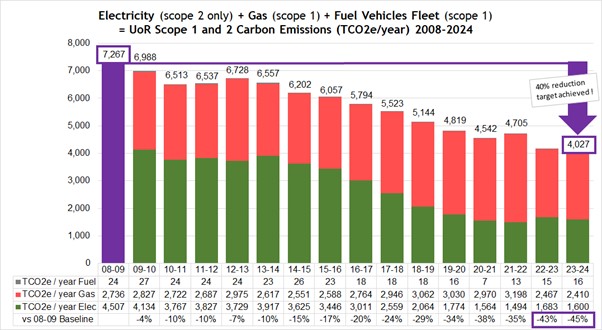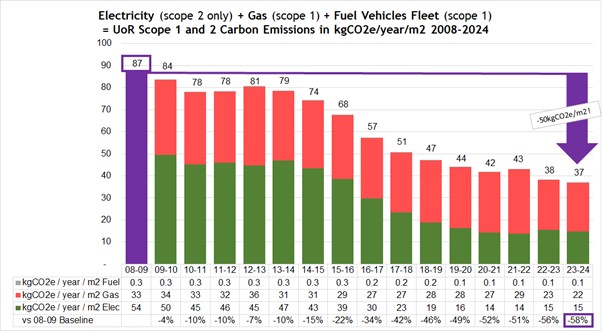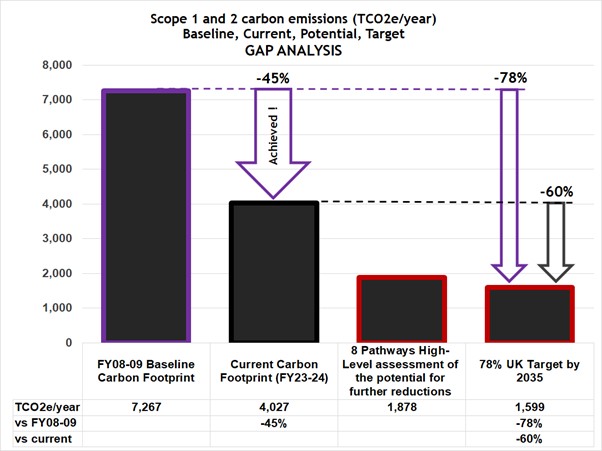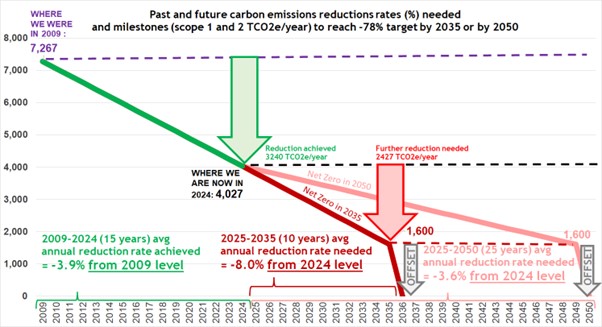In 2011 the University approved our Carbon Management Plan with an ambitious objective to reduce its Scope 1 and 2 carbon emissions by 40% by 2020 against a (now 2008) baseline year.
- Did we achieve our target?
- Where were we then, where are we now, and where do we need to be as an education organisation to contribute mitigating the impacts of the Climate Emergency?
- How far are we from the UK Government legally binding target to slash emissions by 78% by 2035?
To answer these questions, the University’s Energy Manager has produced comprehensive analysis of UoR utilities usage, related costs and carbon emissions in the 14 years period 2008 – 2022 which are now publicly available into our Carbon Management Progress Report.
By publishing our journey and current position with carbon reduction, this report aims to assist the writing of the company’s Net Zero Carbon Strategy to 2050 and recognise the numerous benefits of energy management.
Key projects undertaken
Key energy and water saving projects undertaken between 2008 – 2024 are:
- Over 14,000 luminaires replacements to low-energy low-maintenance quality LED with motion and daylight controls (majority of all 60 buildings converted). Each project typically reduces electricity used for lighting by 80%.
- 508m2 of solar electricity panels installed (2% of our electricity demand).
- 1,750 thermostatic radiator valves installed.
- Voltage optimisation of all 7 main electricity supplies.
- 4,000m2 of 30cm thick loft insulation in all buildings with unoccupied pitched roofs.
- 1,875m of heating pipework insulated.
- Draught-proofing of 615 windows and doors.
- Continuous detection and repair of gas and water leaks.
Highlights from the report are:
- In the last 15 years the University has invested £3.6M in 62 projects with 5 to 10 years payback to reduce utilities usage, associated costs and carbon emissions.
- Thanks to our ‘invest to save’ projects, the equivalent of 1028 tonnes of CO2 per annum (at current carbon factors) is not released into the atmosphere. This is equivalent to driving a petrol car around the UK’s coastline over 1,500 times each year! (Based on 2024 DEFRA emissions factors).
- These projects save the equivalent of powering and heating 313 UK homes, every single year (5000 MWh/year).
- Energy Management is saving the business over £1M per annum in current utilities costs. Energy, which used to cost University of Roehampton £1.8M pa before the energy crisis and is expected to cost £3M in the 2024-25 financial year, would cost £4M/year, should we have not ‘invested to save’. A significant financial benefit for an organisation our size.
- Thanks to our flexible energy purchasing strategy, adopted in 2014, the University has been ‘shielded’ from the worst of the energy prices crisis: without this strategy, UoR would have been impacted by an additional £6.5M in the 2020-23 period, just to pay for electricity and gas. Back in 2015-18 when wholesale gas prices were at an all times low, this variables prices strategy saved the business over £0.5M, the equivalent of 1year of gas at the time!
- These substantial results were achieved with only one Energy Manager.
- After 15 years of carbon reduction efforts, our Scope 1 and 2 carbon emissions have reduced by 45% in absolute terms compared to our 2008-09 baseline year. That is despite a 31% increase in the Estates size in the same period.
As illustrated below, in 2008-09 we released 7267 TCO2e (scope 1 and 2) relative to our usage of electricity, gas and fuel for our vehicles fleet. In 2023-24 this figure is 4027 TCO2e. Thanks to the combined effect of our energy saving projects and the UK decarbonisation of grid electricity, this is an absolute reduction of 3240 TCO2e, the equivalent of over 3200 one-way flights London-New York.
Since 2022-23, we have over-achieved our ambitious 40% carbon reduction target set in our 2011 Carbon Management Plan!
- In relative terms (kgCO2e/year/m2), i.e irrespective of the increase in the size of the Estates, our Scope 1 and 2 carbon emissions have reduced by 58%.
As illustrated below, in 2008-09 we were releasing 87kg of CO2e (scope 1 and 2) per m2 of our Estates. In 2023-24 this figure is 37kg of CO2e per m2, a relative reduction of 50kg of CO2e per m2!
University of Roehampton scope 1 and 2 carbon footprint relative to its usage of electricity, gas and fuel for its vehicles fleet was 7,267 TCO2e/year in our 2008-09 baseline year.
Thanks to the combined effect of our energy saving projects and the UK decarbonisation of grid electricity, and despite a 31% increase in the size of the Estates with 3 new builds in 2015-2017, we have over-achieved, in the space of 15 years, our demanding 40% reduction target set in our 2011 carbon management plan, with an absolute reduction of 45% to 4,027 TCO2e/year in 2023-24!
Whilst this amazing achievement would not have been possible without the determination of its Energy Manager, in post since 2010, the University commitment to invest-to-save, and is certainly cause for celebration, there is unfortunately no time to ‘rest on our laurels’ in the race against climate change:
To meet the UK Net Zero Target, University of Roehampton scope 1 and 2 carbon emissions need to continue to reduce to reach ~1,600 TCO2e/year, a 78% reduction against our 2008-09 baseline year. This actually represent a further 60% reduction against our current 2023-24 carbon emissions and will be very challenging to achieve indeed, as much in volume, than in speed, of reduction.
The remaining carbon emissions we cannot eliminate from our activities are to be offset.

Effectively addressing the environmental and financial impacts of climate change is a significant challenge, and the need for action has never been more urgent.
A key metric to illustrate this is our rate (speed) of reduction:
- Our -45% absolute reduction 2009-2024 (15 years) translates into an average reduction rate of -3.9% per year, from 2009 levels.
- To achieve the -78% UK target and Net Zero by 2050 at the latest, we need to further reduce at an average reduction rate of -3.6% per year, from 2024 levels.
- To achieve the -78% UK target and Net Zero by 2035 as set in the law, we need to further reduce at an average reduction rate of -8% per year, from 2024 levels, in just a decade.
This is graphically represented below.

As the more straightforward and cost-effective carbon-saving projects are gradually exhausted, continuing our reductions from a lower baseline (2024 levels rather than 2009) will present a significant challenge. Maintaining even the same average annual reduction rate (-3.9% per year until 2050) will become increasingly difficult.
Furthermore, to effectively mitigate the environmental and financial impact of climate changes and for UoR to achieve the -78% UK target and Net Zero by 2035 (in just a decade), the University must actually ‘double-up’ its current speed of carbon reduction to an average of 8%, every year, from 2024 level, until 2035.
A very high-level assessment indicates that achieving this demanding target is ‘technically’ possible (as in, having opportunities for further reductions) but, that in terms of the speed, the strategic Estates decisions and the capital funding required, especially in the current context for the Higher Education sector, it will be extremely challenging.
The roadmap we have in mind, however highly beneficial way beyond carbon reduction, assumes the University taking strategic space rationalisation decisions (reduction of the size of the old Estates) and not increasing utilities demand for any of its activities ; sourcing ‘funding solutions’ for large amounts of capital investment for a Building Management System & heating/cooling controls (BMS centralisation phase 1 under way for completion in 2025), a Buildings Insulation Programme, replacement of half of the gas boilers to heat pumps, further opportunities for LED lighting and an Electric Vehicles Fleet; as well as a continuation of the decarbonisation of the UK grid electricity by half, as desired and forecasted in the industry.
It is the main purpose of our Net Zero Carbon Strategy, yet to be developed, to attempt to identify and quantify different pathways that could achieve these ambitious goals, assess at high-level their technical and financial viability and prioritise them for action, in line with other university strategies, such as the Estates Strategy and the Strategic Plan to 2030.








